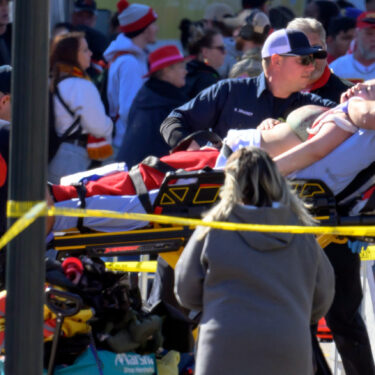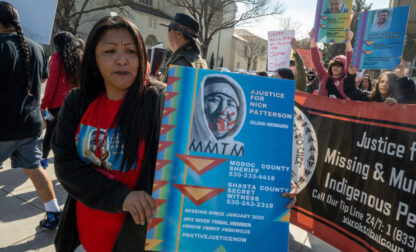Kansas City’s AP staff was just wrapping up what was supposed to be a day of fun as the city was celebrating the Chiefs’ Super Bowl win with a parade and rally. They were regrouping in the office — and some had family nearby at the parade — when shots rang out.
Photographer Charlie Riedel and video journalist Nick Ingram rushed out the door, while correspondent Heather Hollingsworth tried to confirm what happened. After she alerted that shots had been fired — the first of many alerts on this story — she also raced outside, and days of exhaustive coverage began.
Riedel and stringers sent in photos showing the reality of the shooting’s aftermath — people on stretchers, bloodied and shocked. Ingram went live, interviewing people who were stunned by the violence and gathering background video, or b-roll. Hollingsworth sought out witnesses, while other AP staffers helped from afar, including Oklahoma City correspondent Sean Murphy, who jumped in to help stitch the story together as it was developing.
AP’s coverage was a collaboration across teams and formats for the next several days. Topeka correspondent John Hanna profiled the woman who died, and from Jefferson City, Summer Ballentine and David Lieb put together a smart piece on Missouri gun laws.
After interviewing several people who were moved to tears, Hollingsworth stepped back to examine what the shooting meant for the people of Kansas City. In St. Paul, Trisha Ahmed used social media to find and secure an interview with a survivor, whom Ingram and Riedel then went to interview in person, and Hanna turned the interview into a text story.
Scott McFetridge in Des Moines, Jim Salter in St. Louis and Josh Funk in Omaha pitched in on reporting, while Hannah Fingerhut in Des Moines and Sarah Brumfield in Washington helped out with the Things to Know fixture. Ingram and Riedel also got images from a vigil. One key bit of footage came after Hollingworth’s request for surveillance video from AP’s office building. That led to a tenant who had footage that captured the sounds of shots being fired, and the overhead view of a crowd dispersing. The video got tens of thousands of views.
Sports also contributed with Jimmy Golen’s compelling story on security at these types of events, and graphics worked on putting together a map of where the shooting unfolded, while digital worked on stacking the stories and video edits. AP’s radio team pulled audio from video clips to complete the coverage. And the entertainment team helped confirm that Taylor Swift was among those donating to victims. It was amazing coverage overall and true collaboration across teams and formats, during a particularly difficult time for staff on the ground.
AP dominated coverage, and stories were trending for days, with the mainbar, Things to Know fixture, and sidebars consistently taking up two or three of the top five spots for most-viewed stories. The first story and second-day story, about the possible motive, each got roughly a half million page views. Video edits by Ingram and Minneapolis video journalist Mark Vancleave were viewed and downloaded thousands of times.
For leaping into a fast-breaking story, supported by colleagues around the United States, Ingram, Hollingsworth and Riedel earn Best of the Week — First Winner.
Visit AP.org to request a trial subscription to AP’s video, photo and text services.
For breaking news, visit apnews.com.





